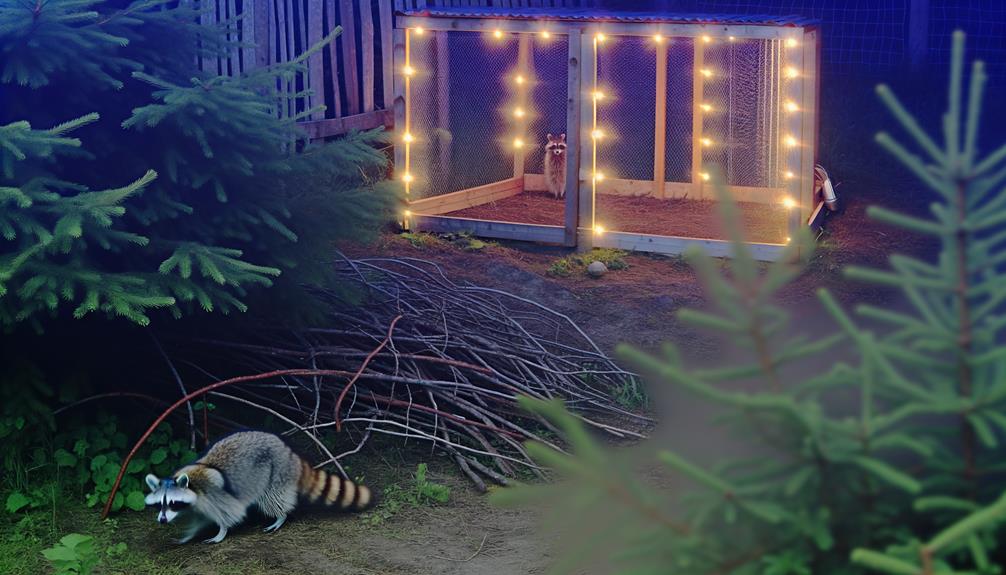Top 3 Tips: Do You Keep Raccoons Away from Your Chickens?
To keep raccoons at bay from chickens, make sure the coop is structurally sound, using heavy-duty materials like galvanized steel or wood. Fortify entry points with hardware cloth and secure all doors with raccoon-resistant locks.
Install predator-resistant fencing with small mesh sizes, buried at least 12 inches underground and standing 6 feet high with an outward-facing overhang. Utilize motion-activated lights to create an unwelcoming environment.
Use natural deterrents such as predator urine and strong-smelling herbs. Regular inspection and maintenance of the coop and fencing are vital to prevent any vulnerabilities.
Enhance your protection measures by understanding these strategies in detail.

Key Takeaways
- Fortify the chicken coop with hardware cloth and secure all entry points.
- Install predator-proof fencing, burying it at least 12 inches underground.
- Use motion-activated lights around the perimeter to deter raccoons.
- Employ natural deterrents like predator urine and strong-smelling herbs.
- Regularly inspect and maintain the coop and fencing for any signs of wear or damage.
Secure the Chicken Coop
One of the most effective measures to protect chickens from raccoons is to make sure that the chicken coop is structurally sound and impenetrable. This involves using strong materials such as galvanized steel or heavy-duty wood, which raccoons cannot easily chew through or manipulate.
Additionally, all entry points, including doors, windows, and ventilation openings, should be fortified with hardware cloth—a wire mesh with small openings that raccoons cannot penetrate. Ensuring tight-fitting doors and secure locks is also important, as raccoons possess remarkable dexterity and can open simple latches.
Inspect the coop regularly for any signs of wear or potential entry points. By prioritizing these structural elements, one can greatly reduce the risk of raccoon predation on chickens.
Install Predator Proof Fencing
Installing predator-proof fencing is an important step in safeguarding chickens from raccoon attacks by providing an additional physical barrier that these cunning animals cannot easily breach.
A strong fencing system should include galvanized hardware cloth with small mesh sizes, ideally no larger than 1/2 inch, to prevent raccoons from reaching through.
The fencing should be buried at least 12 inches underground to deter digging and should extend upward at least 6 feet to prevent climbing.
Additionally, incorporating an outward-facing overhang or electric wire at the top can further enhance security.
Ensuring that all gates and access points are securely latched with raccoon-proof locks is vital.
Use Motion-Activated Lights
Utilizing motion-triggered lights can deter raccoons by surprising them with sudden illumination, thereby creating an environment that is less conducive to their nocturnal activities. These intelligent creatures typically avoid well-lit areas to reduce the risk of exposure to predators. Implementing such a system can be an effective strategy in safeguarding your poultry.
Key considerations for using motion-triggered lights include:
- Placement: Position lights strategically around the perimeter of the chicken coop and other vulnerable areas to maximize coverage.
- Sensitivity: Adjust the sensitivity settings to make sure the lights activate promptly when motion is detected.
- Power Source: Opt for solar-powered models to ensure uninterrupted operation without relying on electrical outlets.
Employing these measures can greatly enhance the security of your chicken enclosure.
Employ Natural Deterrents
Incorporating natural deterrents such as predator urine, strong-smelling herbs, and essential oils can effectively repel raccoons from chicken coops by leveraging their acute sense of smell to create a hostile environment.
Predator urine, specifically from coyotes or foxes, can signal to raccoons that potential threats are nearby. Herbs such as mint, rosemary, and garlic emit odors that raccoons find unpleasant. Essential oils like peppermint and eucalyptus can be diluted and sprayed around the coop perimeter to enhance this effect.
These natural methods not only deter raccoons but also minimize harm to the environment and other wildlife. Utilizing these deterrents can create a safer, more secure environment for your chickens, aligning with sustainable and humane wildlife management practices.
Regularly Inspect and Maintain
Consistent and thorough examinations of the chicken coop, coupled with regular maintenance, are crucial in identifying and addressing vulnerabilities that raccoons might exploit. Routinely evaluating the structural integrity and security measures of your coop will proactively reduce the risk of raccoon invasions.
Key areas to focus on include:
- Fencing and Wire Inspection: Confirm all fencing and wire mesh are intact and securely fastened, with no gaps or weak spots that could be breached.
- Entry Points: Inspect doors, windows, and ventilation openings for any signs of wear or damage, reinforcing them as necessary to prevent unauthorized entry.
- Structural Soundness: Inspect and repair any decaying wood, loose boards, or other structural deficiencies that a determined raccoon might exploit.
Conclusion
To sum up, safeguarding chickens from raccoons requires a multi-dimensional approach involving the securing of the chicken coop, setting up predator-resistant fencing, using motion-triggered lights, and incorporating natural deterrents.
Routine inspection and upkeep are pivotal to guarantee these measures stay efficient. These collective tactics function as a stronghold, establishing an impassable obstacle that deters raccoons, thereby guaranteeing the safety and welfare of the poultry.
Following these techniques can notably diminish the threat of predation.






